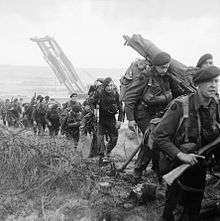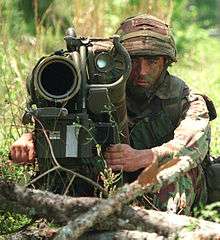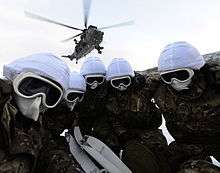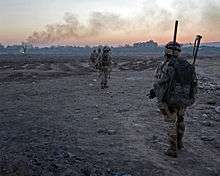45 Commando
| 45 Commando Royal Marines | |
|---|---|
|
Cap Badge of the Royal Marines | |
| Active | 1943– |
| Country |
|
| Branch |
|
| Role | Commando |
| Size | One battalion |
| Part of | Naval Service |
| Garrison/HQ | RM Condor, Arbroath |
| Motto(s) | Per Mare Per Terram (By Sea By Land) (Latin) |
| March |
Quick — A Life on the Ocean Wave Slow — Preobrajensky |
| Commanders | |
| Current commander | Lt Col A Turner RM |
| Captain-General | HRH The Duke of Edinburgh (Captain-General, Royal Marines) |
45 Commando Royal Marines (pronounced "four-five commando") is a battalion sized unit of the British Royal Marines and subordinate unit within 3 Commando Brigade Royal Marines, the principal Commando formation, under the Operational Command of Commander in Chief Fleet.
Tasked as a Commando amphibious unit, 45 Cdo RM is capable of a wide range of operational tasks. Based at RM Condor,[1] their barracks in Arbroath, personnel regularly deploy outside the United Kingdom on operations or training. While 3 Cdo Bde RM are the principal cold weather warfare formation, personnel are capable of operating in a variety of theatres including tropical jungle, desert or mountainous terrain. The Commando is a regular participant in the annual Brigade cold weather warfare exercise in Norway, having been the first UK unit to specialise in the mountain and Arctic warfare role during the early 1970s and deployed to Norway on NATO’s northern flank most years until the end of the Cold War.
All personnel have completed the Commando course at the Commando Training Centre(CTCRM) at Lympstone in Devon, entitling them to wear the green beret, with attached personnel having completed the All Arms Commando Course.
History

5th RM Battalion
The 5th RM Battalion was originally raised for a brief period at the end of World War I (September 1918-February 1919), and was again raised on 2 April 1940 following mass mobilisation and the influx of “hostilities only” (HO) marines. The battalion was raised at Cowshot Camp in Brookwood (now part of the Pirbright Camp complex), being incorporated into 101 RM Bde, along with the 1st RM Battalion. Between August and October 1940 the battalion took part in operations in Dakar. On return until August 1943 the battalion conducted extensive training in Wales, Scotland, the Isle of Wight and Burley, where the battalion reformed as 45 RM Commando on 1 August 1943.[2]
45 RM Commando
After reforming and retitling, the unit transitioned to the Commando role as a formed unit, by-passing the individual volunteer and selection process undertaken by Army Commando candidates. Personnel undertook, and completed, the Commando Basic Training Course at Achnacarry, Scotland. As part of the 1st Special Service Brigade the Commando participated in Operation Overlord, the D-Day Normandy landings, going on to move through Europe into Germany, including Montforterbeek on 23 January 1945.[3]
Post-World War II reorganisation
Following the Second World War both 1 Commando Brigade (Nos 3, 4 and 6 Army Commandos and 45 RM Commando) and 2nd Commando Brigade (Nos 2 and 9 Army Cdos and 40 and 43 RM Cdos) disbanded, leaving 3 Cdo Bde (then comprising 1 and 5 Army Cdos and 42 and 44 RM Cdos) in place in the Far East. 3 Cdo Bde reorganised, disbanding 1 and 5 Army Cdos, and took on 45 RM Cdo, which joined the Bde in Hong Kong, from the UK, in January 1946. In order to preserve the heritage of a 2 Cdo Bde unit, as well as that of 1 Cdo Bde (45 RM Cdo), 44 Commando was retitled 40 Commando (which had been disbanded in UK in October 1945) and took on 40 RM Cdo’s colours, battle honours and traditions, albeit with 44 RM Cdo’s manpower. The three remaining commandos were restyled 40, 42 and 45 Commandos RM in March 1946.[4]
1940s/1950s
_Suez_1956.jpg)
The Commando was based in Hong Kong between January 1946 and May 1947, conducting internal security duties, as part of 3 Cdo Bde RM. Between May 1947 and December 1948 the Commando moved to Malta, during which time it deployed to Libya, Palestine, Suez and Jordan. The Commando returned to Hong Kong in December 1948 and from there deployed to Malaya between 1950 and 1952 taking part in operations during the Emergency. Between 1952 and 1959 the Commando was once again based in Malta. In September 1955 45 Commando was deployed to Cyprus to undertake anti-terrorist operations against the EOKA guerrillas during tensions between the Greek and Turkish inhabitants of the island. The EOKA were a small, but powerful organisation of Greek Cypriots, who had great local support from the Greek community. The unit travelled to the Kyrenia mountain area of the island and in December 1955 launched Operation Foxhunter, an operation to destroy EOKA's main base.[5]
Then in 1956 the unit deployed to Egypt as part of the response to the Suez Crisis, conducting a helicopter assault.[6]
1960s
Between 1960 and 1967 the Commando was based in Aden, from where it conducted 10 operational tours in the Radfan during the Aden Emergency. The Commando also deployed briefly to Kuwait following an Iraqi threat to her Independence in 1961. In January 1964, part of the Tanzanian Army mutinied. Within 24 hours elements of 45 Commando had left Bickleigh Camp, Plymouth, Devon, and were travelling by air to Nairobi, Kenya, continuing by road into Tanzania. At the same time, Commandos aboard HMS Bulwark sailed to East Africa and anchored off-shore from Dar es Salaam, Tanzania. The revolt was put down and the next six months were spent in touring Tanzanian military out-posts disarming military personnel.[7] The last elements of the Commando left Aden on 29 November 1967 to return to the UK for the first time since the end of World War II. They set up home in Stonehouse Barracks, Plymouth.[8]
1970s/1980s
In 1970 the Commando began Arctic training for the first time, taking on the role of Britain’s mountain and Arctic warfare experts (joined later by the other Commandos). 45 Cdo RM deployed to Norway for the first of many winters in 1971, which coincided with a move of the unit from Stonehouse, Plymouth to the old Naval Air Station, RNAS Arbroath (now RM Condor) in Arbroath, Scotland, where the unit still remains.[9] This period in the unit’s history is characterised by the alternation of Northern Ireland tours[8] and winters in Norway, protecting NATO’s northern flank.[10]
Falklands War
Following the Argentine invasion of 2 April 1982, 45 Cdo RM, under the command of Lieutenant Colonel Andrew F. Whitehead RM, had their Easter leave cancelled and hastily deployed to the Falklands, travelling in a mix of Royal Navy (RN) and Royal Fleet Auxiliary (RFA) ships. Having made a tactical landing at Red Beach, Ajax Bay on 21 May 1982, the men of 45 Cdo RM yomped across East Falkland, via Port San Carlos, New House, Douglas Settlement, Teal Inlet and Mount Kent to take part in the Battle for Port Stanley. They conducted a night attack on the Two Sisters feature over the 11/12 June 1982,[3] during which the Commando lost 8 men killed and 17 wounded. The Argentinians surrendered on 14 June 1982. Lt. Col Whitehead was awarded the Distinguished Service Order (DSO).[11]
1990s

The Commando deployed to Northern Iraq on Operation Haven at the end of the Gulf War, where it spent 2 months in the Zakho area, withdrawing at the end of June. In 1993 The Commando was deployed to Belize for the last operational jungle tour in that country. In a mirror image of its 1961 deployment to Kuwait, the Commando returned on Operation Driver in 1994, in support of Kuwait, following some threatening troop movements by the Iraqis on their side of the border. In 1998 the Commando was redirected from an exercise in Belize, to assist Nicaragua and Honduras following the devastation caused by Hurricane Mitch.[12]
2000s


At the turn of the Millennium, the Commando was deployed to Kosovo under KFOR as part of 3 Cdo Bde RM on Operation Agricola IV.[13][14] From April 2002, the unit deployed to Afghanistan on Operation Jacana, and also took part in Operation Telic 1, the 2003 invasion of Iraq. X-Ray Company Group was attached to the Special Boat Service (SBS), Whiskey Company Group attached to the Special Air Service (SAS).[15]
In September 2003, 45 Commando was granted the Freedom of Angus in recognition of their service in Iraq and Afghanistan and contribution to the local economy of Arbroath, where they are based at.[16]
In January 2004 the unit deployed to Northern Ireland (Operation Banner) for 6 months in support of peacekeeping operations, returning home in June. On return, it became the Spearhead Lead Commando, a role assumed on a rotational basis. The Lead Commando is at a high level of readiness, able to deploy at short notice on operations worldwide.[17]
In September 2004, whilst still Lead Commando, the Group deployed to the United States on Exercise BLACKHORSE. This was split into two phases, the first of which took place with the United States Marines Corps Ground-Air Combat Centre at 29 Palms, California. This 900 square miles of desert, allowed realistic live firing, involving artillery and air strikes. The second phase took place at the Marine Corps Mountain Warfare Training Centre, high in the Sierra Nevada Mountains. An early snowfall meant the Commando was able to carry out cold weather warfare training, operating between 7000 and 11,000 feet (3,400 m). 2006 saw the Unit deploy to Norway for further Arctic training which culminated with a NATO led exercise.[18]
The focus switched to preparation for deploying to Afghanistan on Operation HERRICK 5 in late 2006. This deployment saw the Commando take on a number of different roles, the principal one being that of the Operational Mentoring and Liaison Team (OMLT). The OMLT task was to work alongside the Afghan National Army and develop it into a self-sufficient organisation. The Unit returned from Afghanistan in April 2007.[19]
October 2008 saw the Commando return to Afghanistan as Northern Battle Group in Helmand Province on Operation HERRICK 9. The operational area of responsibility was the Upper Sangin Valley which extended for 80 km along the length of the Helmand River. The Battle Group was in excess of 1200 strong, half of whom came from 45 Commando.[20]
April/May 2009 saw the return of the Commando to Arbroath in Scotland for reorganisation ahead of a winter deployment to Norway to practice cold weather and amphibious tactics.[16]
2010s
45 Commando deployed to Afghanistan again, as part of 3 Commando Brigade, for 6 months in March 2011 on Operation Herrick 14. They returned home in October 2011.[21][22]
45 Commando was the lead commando group for the UK until May 2013, able to deploy at short notice.[23] In October 2013 Whiskey Company from 45 Commando exercised in Ghana with US, Dutch and Spanish Marines.[24][25]
In May 2016 45 Commando Royal Marines provided the guard of honour during Beating Retreat 2016 of the Bands of Her Majesty's Royal Marines to celebrate the birthday of their Captain General HRH Prince Philip, Duke of Edinburgh.[26]
Structure
- Whiskey Company
- Zulu Company
Commanding officers
Commanders have included:
As 5 RM Bn
- 1940–1942 Lt Col H E Reading RM
- 1942–1942 Lt Col S G Cutler RM (February – September)
- 1942–1943 Lt Col K Hunt RM
As 45 RM Commando
- 1943–1944 Lt Col N C Ries RM
- 1944–1945 Lt Col W N Gray DSO RM
- 1945–1945 Lt Col A L Blake MC RM (March – April)
- 1945–1945 Lt Col W N Gray DSO RM (April – July)
- 1945–1945 Lt Col I D De'ath DSO MBE RM (July – December)
- 1945–1946 Lt Col R D Houghton MC RM
As 45 Commando RM
- 1946–1948 Lt Col T M Gray DSO MC RM
- 1948–1948 Lt Col E C E Palmer DSO RM (January – July)
- 1948–1948 Lt Col P L Norcock RM (July – November)
- 1948–1950 Lt Col N C Ries OBE RM
- 1950–1952 Lt Col R C de M Leathes MVO OBE RM
- 1952–1954 Lt Col F A Eustace OBE RM
- 1954–1956 Lt Col N H Tailyour DSO RM
- 1956–1956 Lt Col R D Crombie RM (November – December)
- 1956–1957 Lt Col N H Tailour DSO RM
- 1957-1958 Lt Col J Richards OBE RM
- 1958–1958 Lt Col R D Crombie RM (July – September)
- 1958–1960 Lt Col F C Barton RM
- 1960–1962 Lt Col L G Marsh MC RM
- 1962–1963 Lt Col N S E Maude RM
- 1963–1964 Lt Col T M P Stevens MC RM
- 1964–1966 Lt Col R J McGarel Goves RM
- 1966–1967 Lt Col F C E Bye RM
- 1967–1968 Lt Col J I H Owen OBE RM
- 1968–1969 Lt Col J C C Richards RM
- 1969–1971 Lt Col R J Ephraums OBE RM
- 1971–1974 Lt Col Sir Steuart Pringle Bt RM
- 1974–1976 Lt Col L E Hudson RM
- 1976–1978 Lt Col J St J Grey RM
- 1978–1981 Lt Col B H B Learoyd RM
- 1981–1983 Lt Col A F Whitehead DSO RM
- 1983–1985 Lt Col I M H Moore RM
- 1985–1987 Lt Col A M Keeling RM
- 1987–1989 Lt Col S J Pack RM
- 1989–1991 Lt Col J J Thompson OBE RM
- 1991-1993 Lt Col D V Nicolls RM
- 1993-1995 Lt Col D Wilson OBE RM
- 1995–1997 Lt Col R A Fry MBE RM
- 1997–1999 Lt Col J H Thomas RM
- 1999–2001 Lt Col G S Robison RM
- 2001–2003 Lt Col S T Chicken OBE RM
- 2003–2004 Lt Col T J Bevis RM
- 2004–2006 Lt Col N P Lindley RM
- 2006–2007 Lt Col D A Dewar RM
- 2007–2009 Lt Col J A J Morris DSO RM
- 2009-2011 Lt Col O A Lee MBE RM
- 2011-2013 Lt Col M J Tanner RM
- 2013-2015 Lt Col D J Cheesman MBE RM
Battle honours
The following Battle honours were awarded to the British Commandos during the Second World War.[27]
- Adriatic
- Alethangyaw
- Aller
- Anzio
- Argenta Gap
- Burma 1943–45
- Crete
- Dieppe
- Dives Crossing
- Djebel Choucha
- Flushing
- Greece 1944–45
- Italy 1943–45
- Kangaw
- Landing at Porto San Venere
- Landing in Sicily
- Leese
- Litani
- Madagascar
- Middle East 1941, 1942, 1944
- Monte Ornito
- Myebon
- Normandy Landing
- North Africa 1941–43
- North-West Europe 1942, 1944–1945
- Norway 1941
- Pursuit to Messina
- Rhine
- St. Nazaire
- Salerno
- Sedjenane 1
- Sicily 1943
- Steamroller Farm
- Syria 1941
- Termoli
- Vaagso
- Valli di Comacchio
- Westkapelle
Coordinates: 56°34.821′N 2°37.745′W / 56.580350°N 2.629083°W
References
Notes
- ↑ Royal Marines Commando — Individual Unit Histories. Former HMS Condor which became RM Condor in 1971.
- ↑ "45 Royal Marine Commando: The Normandy Landings". Combined Operations. Retrieved 17 April 2016.
- 1 2 "Memorial dates" (PDF). Royal Navy. Retrieved 17 April 2016.
- ↑ "Royal Marines Commando and Special Boat Service". Commando Veterans Association. Retrieved 17 April 2016.
- ↑ French, p. 134
- ↑ "1956: Allied Forces take control of Suez". BBC. Retrieved 4 April 2016.
- ↑ "The Tanganyika Army Mutiny 1964 and The BFPO Field Post Office". GB Stamp. 11 November 2014. Retrieved 22 May 2016.
- 1 2 "Air Troop 45 Commando RM". British Army Units 1945 on. Retrieved 17 April 2016.
- ↑ "Arbroath's military men". BBC. 19 March 2002.
- ↑ Fowler, p. 25
- ↑ The London Gazette: (Supplement) no. 49134. p. 12834. 8 October 1982. Retrieved 17 April 2016.
- ↑ "Mitch: Picking up the pieces". BBC. 18 November 1998. Retrieved 17 April 2016.
- ↑ "UK's mountain warfare elite". BBC. 18 March 2002.
- ↑ "House of Commons - Written Answers for 4 Oct 2004 (pt 31)". Parliamentary Debates (Hansard). House of Commons. 4 October 2004.
- ↑ "Royal Marines - Operation Telic". Elite UK Forces. Retrieved 17 April 2016.
- 1 2 "Thousands turn out in Arbroath to greet returning Royal Marines". Daily Record. 22 May 2009.
- ↑ Ministry of Defence annual report 2005-2006
- ↑ "Defence written question". House of Commons. 23 October 2013. Retrieved 17 April 2016.
- ↑ "Handover in Helmand as 3 Cdo Brigade replace 16 Air Assault Brigade". Ministry of Defence. 9 October 2006.
- ↑ "3 Commando Brigade to replace 16 Air Assault in Afghanistan". Ministry of Defence. 8 July 2008. Archived from the original on 8 July 2008.
- ↑ "3 Commando Brigade Take Command Of Task Force Helmand". Ministry of Defence. 11 April 2011.
- ↑ "3 Commando Brigade to replace 16 Air Assault Brigade in Helmand". Ministry of Defence. 17 December 2010.
- ↑ "Royal Marines end cold weather training with three hour battle". Retrieved 4 April 2016.
- ↑ "Exercise African Winds blows through Ghana". Retrieved 4 April 2016.
- ↑ "Marines rehearse casualty evacuations in Benin". Retrieved 4 April 2016.
- ↑ "Defence in the Media – 26 May 2016". Retrieved 28 May 2016.
- ↑ Moreman, p.94
Bibliography
- French, David (2015). Fighting EOKA: The British Counter-Insurgency Campaign on Cyprus, 1955-1959. Oxford University Press. ISBN 978-0198729341.
- Fowler, Will (2009). Royal Marine Commando 1950-82: From Korea to the Falklands. Osprey. ISBN 978-1846033728.
- Moreman, Timothy Robert (2006). British Commandos 1940–46. Osprey Publishing. ISBN 1-84176-986-X.
- Samain, Brian (2005). Commando Men: The Story of a Royal Marine Commando in World War Two. Pen and Sword. ISBN 184415209X.
- Young, David (1972). Four Five: Story of 45 Commando Royal Marines 1943-1971. Leo Cooper. ISBN 0850520932.
External links
| Wikimedia Commons has media related to 45 Commando Royal Marines. |
